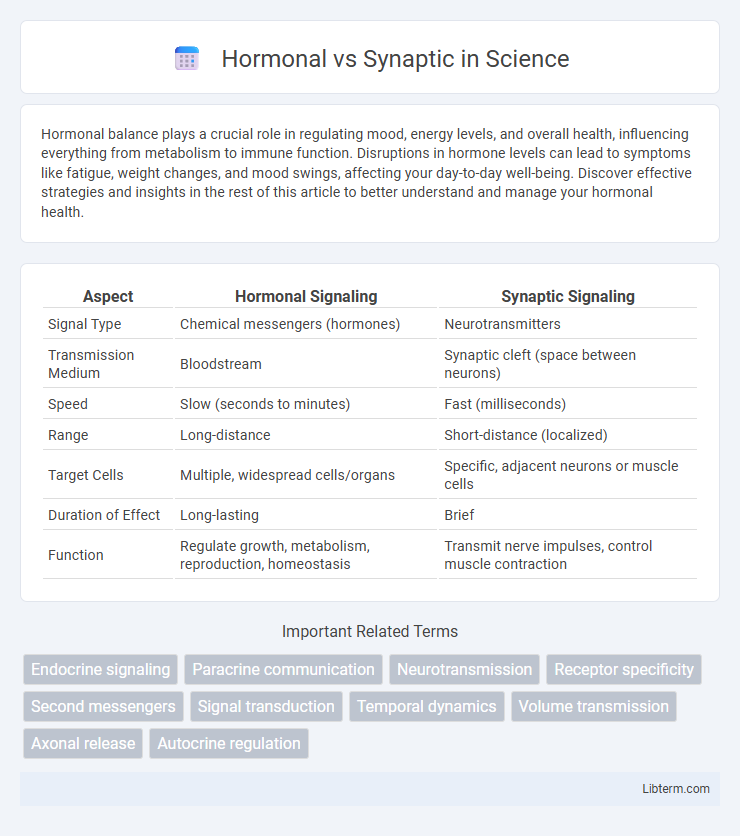Hormonal balance plays a crucial role in regulating mood, energy levels, and overall health, influencing everything from metabolism to immune function. Disruptions in hormone levels can lead to symptoms like fatigue, weight changes, and mood swings, affecting your day-to-day well-being. Discover effective strategies and insights in the rest of this article to better understand and manage your hormonal health.
Table of Comparison
| Aspect | Hormonal Signaling | Synaptic Signaling |
|---|---|---|
| Signal Type | Chemical messengers (hormones) | Neurotransmitters |
| Transmission Medium | Bloodstream | Synaptic cleft (space between neurons) |
| Speed | Slow (seconds to minutes) | Fast (milliseconds) |
| Range | Long-distance | Short-distance (localized) |
| Target Cells | Multiple, widespread cells/organs | Specific, adjacent neurons or muscle cells |
| Duration of Effect | Long-lasting | Brief |
| Function | Regulate growth, metabolism, reproduction, homeostasis | Transmit nerve impulses, control muscle contraction |
Introduction to Hormonal and Synaptic Communication
Hormonal communication involves the release of hormones into the bloodstream, allowing signals to reach distant target cells and regulate long-term physiological processes such as growth, metabolism, and reproduction. Synaptic communication occurs through neurotransmitter release at synapses, enabling rapid, localized transmission of electrical signals between neurons for immediate responses. Both communication types are crucial for maintaining homeostasis, with hormonal signaling typically slower and widespread, while synaptic signaling is fast and precise.
Defining Hormonal Signaling
Hormonal signaling involves the secretion of hormones by endocrine glands into the bloodstream, allowing these chemical messengers to reach distant target cells and regulate physiological processes. Unlike synaptic signaling, which relies on neurotransmitters transmitted across synapses for rapid, localized communication, hormonal signaling produces slower, widespread effects over longer durations. Key hormones such as insulin, adrenaline, and cortisol exemplify this mechanism by modulating metabolism, stress responses, and homeostasis through systemic distribution.
Understanding Synaptic Transmission
Synaptic transmission involves the precise release of neurotransmitters from presynaptic neurons into the synaptic cleft, enabling rapid and targeted communication with postsynaptic cells. This process relies on the binding of neurotransmitters to specific receptors, triggering electrical or chemical responses essential for neural signaling. Unlike hormonal signaling, synaptic transmission provides fast, localized control within neural circuits critical for functions such as movement, sensation, and cognition.
Key Differences: Hormonal vs Synaptic Mechanisms
Hormonal mechanisms involve the release of hormones into the bloodstream, allowing them to travel long distances to target cells, enabling widespread and prolonged effects throughout the body. Synaptic mechanisms rely on neurotransmitters released at synapses, facilitating rapid, localized, and short-term communication between neurons. Key differences include the speed of signal transmission, with synaptic communication occurring milliseconds, whereas hormonal responses may take seconds to hours, and the specificity of target cells, where synapses target specific postsynaptic neurons and hormones influence multiple tissues.
Speed and Specificity of Signal Transmission
Synaptic signaling transmits signals rapidly within milliseconds through neurotransmitters released at synapses, ensuring highly specific communication between adjacent neurons. Hormonal signaling operates more slowly, often taking seconds to minutes, as hormones travel through the bloodstream to target distant cells, resulting in broader but less specific effects. The speed difference stems from the direct synaptic cleft transmission versus systemic circulation required for hormonal action.
Duration and Range of Effects
Hormonal communication involves endocrine glands releasing hormones into the bloodstream, resulting in effects that have a long duration and widespread influence on various target organs throughout the body. Synaptic communication occurs at synapses between neurons, producing rapid and localized responses with effects lasting only milliseconds to seconds. The extended range and persistence of hormonal effects contrast sharply with the precise and transient actions characteristic of synaptic signaling.
Examples of Hormonal Communication in the Body
Hormonal communication in the body is exemplified by the secretion of insulin from the pancreas to regulate blood glucose levels and the release of adrenaline from the adrenal medulla during stress responses. Another key example includes the thyroid gland producing thyroxine to control metabolism and growth. These hormones travel through the bloodstream, affecting distant target organs and coordinating systemic physiological processes.
Examples of Synaptic Communication in the Nervous System
Synaptic communication in the nervous system involves the release of neurotransmitters such as dopamine, serotonin, and acetylcholine from presynaptic neurons into the synaptic cleft to transmit signals to postsynaptic neurons. Examples include the neuromuscular junction, where acetylcholine facilitates muscle contraction, and the dopaminergic synapses in the brain's reward pathways regulating mood and behavior. This precise, rapid signaling contrasts with hormonal communication, which involves slower, longer-lasting effects through bloodstream hormone distribution.
Roles in Homeostasis and Response Regulation
Hormonal signaling regulates long-term homeostasis by releasing hormones into the bloodstream to affect distant target organs, maintaining processes like metabolism, growth, and fluid balance. Synaptic signaling enables rapid, precise communication between neurons and target cells, critical for immediate response regulation such as muscle contraction and reflex actions. Together, hormonal and synaptic mechanisms coordinate systemic stability and adaptive responses to internal and external stimuli.
Clinical Implications of Hormonal and Synaptic Disorders
Hormonal disorders such as hypothyroidism and diabetes mellitus result from endocrine gland dysfunction, leading to systemic effects that require hormone replacement or regulatory therapies. Synaptic disorders, including myasthenia gravis and epilepsy, involve impaired neuronal communication, necessitating treatments targeting neurotransmitter balance or synaptic function restoration. Understanding the distinct mechanisms of hormonal and synaptic disorders facilitates precise clinical interventions and improves patient outcomes.
Hormonal Infographic

 libterm.com
libterm.com